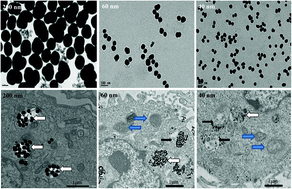Cytotoxicity and autophagy dysfunction induced by different sizes of silica particles in human bronchial epithelial BEAS-2B cells
Abstract
The adverse effects of silica nanoparticles are gaining attention due to their wide application in biomedicine. However, information about size-dependent toxicity induced by silica nanoparticles is insufficient. In this study, two size of nano-scale (40 nm, 60 nm) and one size of micro-scale (200 nm) silica particles were studied to investigate the possible mechanism of cytotoxicity and autophagy dysfunction in human bronchial epithelial BEAS-2B cells. The cell viability was decreased in a size- and dose-dependent manner, while the LDH activity, oxidative stress and mitochondrial damage significantly increased, induced by both nano- and micro-scale silica particles. Ultrastructural analysis showed that nano-scale silica particles could induce mitochondrial damage and autophagy, but not micro-scale particles. Verified by the autophagy inhibitor 3-MA, the expression of LC3 and SQSTM1/p62 was upregulated in nano-scale silica particles in a size- and dose-dependent manner, while the micro-scale particles had an inhibitory effect. In addition, autophagy activation and autophagy blockage were triggered by nano-scale silica particles via the PI3K/Akt/mTOR pathway. Our findings first demonstrated that exposure to nano-scale silica particles rather than micro-scale particles could lead to autophagy dysfunction and impair cellular homeostasis.


 Please wait while we load your content...
Please wait while we load your content...